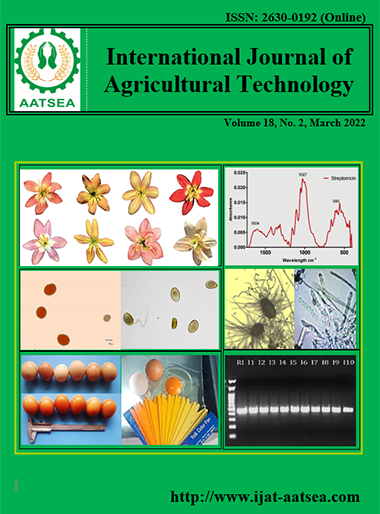Improvement of wool dyeing quality and its antimicrobial activity using nano forms of silver
Main Article Content
Abstract
In conjunction with the increasing public awareness of the infectious diseases, textile industry and scientists are developed hygienic fabrics by the addition of various antimicrobial compounds. The current investigation was carried out using nano-silver applied to wool fibers for studying its effects on wool quality and antimicrobial resistance. Antimicrobial activity is investigated against a broad range of microorganisms including bacteria, yeast and fungi. Moreover, dyeing of wool fibers treated with silver nitrate with extracted dye from the filamentous fungus, Pencillium purpurogenum by using innovation technique to save energy and time. In order to obtain color of aimed specific red hue, the influence of certain dyeing process conditions namely dyestuff concentration, pH, temperature, and duration of the dyeing process were studied. Antimicrobial effect is derived from nano-silver particles (diameter between 1 and 100 nm) which are adhered to the fibers. The fibers treated with silver particles was dyed by the investigated dye, and the antimicrobial activity was recorded. The wool materials showed antimicrobial effects by killing and/or suppressing growth of a broad spectrum of microbes such as Bacillus subtilis, Escherichia coli, Candida albicans and Aspergillus niger. The results indicated that nano-silver application was reflected positively on the zones of growth inhibition of wool fibers E. coli gave the highest diameter of the inhibition zone. On the hand, the applied pigment and the nano forms showed minimum effect on C. alibicans and A. niger
Article Details

This work is licensed under a Creative Commons Attribution-NonCommercial-NoDerivatives 4.0 International License.
References
Abd-Elsalam, I. S. and Ali, N. F. (2020). Investigation of microbial pigment production and its, assessment of wool fibre dyeing. International Journal of Agricultural Technology, 16:771-784.
Alexandra N. Lucas, C. and Cecilra, O. (2014). Transpor and utilization of hexoses and pentoses in the halotolerant yeast Debryomycesfansenti. Applied and Environmental Microbiology, 65:3594- 3598.
Ali, N. F. and Abd- Elsalam, I. S. (2020). Antimicrobial characteristics of wool fibers treated with chitosan-propolis nano composite and dyed with natural dye extracted from Red Prickly Pear, International Journal of Agricultural Technology, 16:223-236.
Ali, N. F., El-Khatib, E. M., El-Mohamedy R. S. S. and Ramadan M. A. (2014). Antimicrobial activity of silk fabrics dyed with saffron dye using microwave heating. International Journal of Current Microbiology and Applied Sciences, 3:140-146.
Ali, N. F., El-Khatib, E. M., El-Mohamedy, R. S., Nassar, S. H., El-Shemy, N. S. (2019). Dyeing properties of wool fibers dyed with rhubarb as natural dye via ultrasonic and conventional methods. Egyptian Journal of Chemistry, 62:119 -130.
Chun, D. T. W. and Gamble, G.R. (2007). Using the reactive dye method to covalently attach antibacterial compound to cotton. Journal of Cotton Science, 11:154-158.
Dhanalakshmi, M., Thenmozhi, S., Manjula Devi, K. and Kameshwarm, S. (2013). Silver nanoparticles and its antibacterial activity. nternational Journal of Pharmaceutical & Biological Archives, 4:819-826.
Firdhouse, MJ. and Lalitha, P. (2015). Biosynthesis of Silver Nanoparticles and Its Applications. Journal of Nanotechnology, 18: 23-44.
Gao, Y. and Cranston, R. (2008). Recent advances in antimicrobial treatments of textiles. Textile Research Journal, 78:60-72.
Gozde Konuray and Zerrinerginkaya, D. (2018). Antimicrobial and antoxidant properties of pigment synthesized from microorganisms. Review. International Journal of PharmTech Research, 3:10-15.
Lansdown, A. B. (2002). Silver. 1. Its antibacterial properties and mechanism of action. Journal Wound Care, 11:125-130.
Morones, J., Elechiguerra, J., Camacho, A., Holt, K., Kouri, JB. and Ramirez, J. (2005). The bactericidal effect of silver nanoparticles Nanotechnology, 16:2346-2353.
Mukhopadhyay, O., Dhole, S., Mandal, B. K., Khan, F.-R. N. and Ling, Y. C. (2019). Synthesis, characterization and photocatalytic activity of Zn2+, Mn2+ and Co2+ doped SnO2 nanoparticles. Biointerface Research in Applied Chemistry, 9:4199-4204.
Nicoara, A. I., Ene, V. L., Voicu, B. B., Bucur, M. A., Neacsu, I. A., Vasile, B. S. and Iordache, F. (2020). Biocompatible Ag/Fe-Enhanced TiO2 Nanoparticles as an Effective Compound in Sunscreens. Nanomaterials, 10:570.
Oini, N., Ashkani, M. and Kabiri, K. (2020) Microwave-Assisted Modification of Nonwoven Fabric: Inducing Absorbency and Antibacterial Properties. Fibers Poly, 21:1857-1867.
Patra, J. K. And Gouda, S. (2013) Application of nanotechnology in textile engineering: an overview. ournal ofEngineering and Technology Research, 5:104-111.
Panacek, A., Kvitek, L., Prucek, R., Kolar, M., Vecerova, R. and Pizurova, N. (2006). Colloid nanoparticles: synthesis, characterization, and their antibacterial activity. Journal of Physical Chemistry: Part B,110:16248-53.
Pabba, D. (2015). Antibacterial activity of textile fabrics treated with red pigment from marine bacteria. Material sciences, 10:23-34.
Rajni, S., Astha, J., Shikha, P. and Deepti, G. (2005). Antimicrobial activity of some natural dyes’, Dyes and pigment, 66:99-102.
Rivero, PJ., Urrutia, A. and Goicoechea, J. (2015). Nanomaterials for Functional Textiles and Fibres. Nanoscale Research Letters, 10:501.


